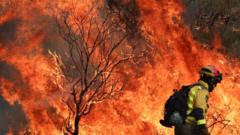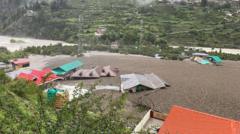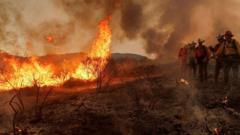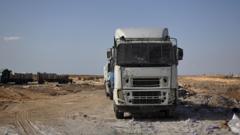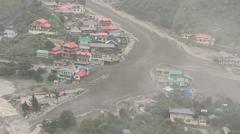In the wake of devastating monsoon rains, flash floods in Pakistan and Pakistan-administered Kashmir have resulted in the deaths of at least 164 individuals, primarily in the northern province of Khyber Pakhtunkhwa. The chaos was exacerbated by landslides, the destruction of homes, and a tragic helicopter crash during rescue operations. As forecasters predict more rain, the government has declared several regions disaster zones, signaling a worsening humanitarian crisis amid ongoing climate challenges.
Tragic Toll: Flash Floods Claim Over 160 Lives in Pakistan and Kashmir
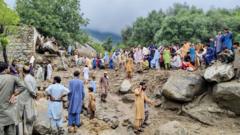
Tragic Toll: Flash Floods Claim Over 160 Lives in Pakistan and Kashmir
Recent heavy monsoon rains have led to catastrophic flash floods causing substantial loss of life and destruction across Pakistan and Pakistan-administered Kashmir.
The heavy rains began to affect the region significantly, leading to flooding and landslides across various areas. The most severe impact has been reported in Khyber Pakhtunkhwa, where disaster management authorities documented around 150 deaths. Tragically, the crash of a rescue helicopter while responding to the crisis resulted in the loss of all five crew members onboard.
Additionally, Pakistan-administered Kashmir has seen at least nine fatalities, while five deaths were reported in Gilgit-Baltistan. The community’s grief was palpable in Bajaur, where a crowd gathered around rescue efforts, mourning for lost loved ones as funerals commenced.
Forecasters have warned of continued heavy rainfall, lasting until August 21, prompting authorities to issue alerts for additional flooding in northwest Pakistan. The chief minister of Khyber Pakhtunkhwa, Ali Amin Gadapur, relayed details about the helicopter crash, attributing it to adverse weather conditions prevalent in the region.
In the Indian-administered section of Kashmir, rescuers battled through mud and debris on Friday to retrieve victims after a flood swept tragically through a village, resulting in at least 60 deaths. The Indian-administered region bore the brunt of harsh monsoon conditions, which traditionally last from June until September, contributing to seasonal flash floods and landslides.
Climatologists have indicated that climate change is exacerbating the severity and frequency of such extreme weather events in South Asia, as Pakistan grapples with a significantly challenging rainy season this year. Recent weeks have shown Punjab, home to a substantial portion of Pakistan's population, reported rainfall greater than 70% compared to the previous year, alongside the rising death toll.
Additionally, Pakistan-administered Kashmir has seen at least nine fatalities, while five deaths were reported in Gilgit-Baltistan. The community’s grief was palpable in Bajaur, where a crowd gathered around rescue efforts, mourning for lost loved ones as funerals commenced.
Forecasters have warned of continued heavy rainfall, lasting until August 21, prompting authorities to issue alerts for additional flooding in northwest Pakistan. The chief minister of Khyber Pakhtunkhwa, Ali Amin Gadapur, relayed details about the helicopter crash, attributing it to adverse weather conditions prevalent in the region.
In the Indian-administered section of Kashmir, rescuers battled through mud and debris on Friday to retrieve victims after a flood swept tragically through a village, resulting in at least 60 deaths. The Indian-administered region bore the brunt of harsh monsoon conditions, which traditionally last from June until September, contributing to seasonal flash floods and landslides.
Climatologists have indicated that climate change is exacerbating the severity and frequency of such extreme weather events in South Asia, as Pakistan grapples with a significantly challenging rainy season this year. Recent weeks have shown Punjab, home to a substantial portion of Pakistan's population, reported rainfall greater than 70% compared to the previous year, alongside the rising death toll.



